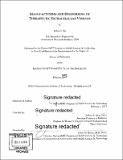Manufacturing and engineering of therapeutic extracellular vesicles
Author(s)
Ng, Kelvin S.
Download1121596010-MIT.pdf (13.82Mb)
Alternative title
Manufacturing and engineering of therapeutic EVs
Other Contributors
Harvard--MIT Program in Health Sciences and Technology.
Advisor
Jeffrey M. Karp.
Terms of use
Metadata
Show full item recordAbstract
Originally viewed as 'garbage bags' which cells release to dispose of unwanted material, extracellular vesicles (EVs) have emerged as potent messengers that package and disseminate biochemical signals. This newly recognized mode of communication between cells has brought unprecedented therapeutic opportunities; at least 8 clinical trials and 7 companies are investigating or developing EVs as therapeutic products. As the EV industry rapidly grows, there is a rising demand for strategies that facilitate EV manufacturing. In this thesis, we address several challenges in EV manufacturing. By quantifying how many EVs a cell can release before it divides, we discovered that EV output increases as cells divide more slowly, providing a new way to maximize EV output from cells. Using our mathematical description of EV output, we built a computational model to estimate costs of EV manufacturing. Selecting cells with higher EV output despite slower proliferation can drastically lower costs. Meanwhile, although ultracentrifugation is the current standard for purifying EVs, we found that ultrafiltration-specifically tangential-flow filtration-is a more economical and scalable alternative, and we experimentally determined its utility for scaling up EV purification. For quality control, we established a suite of potency assays to measure the overall inflammatory action of EVs derived from human stem cells. Significant variability in EV potency between cells of different donors was detected, substantiating the need to robustly screen for appropriate cell sources when manufacturing EVs. Towards controlling EV function, we genetically constructed a versatile, multi-domain ligand that localizes to and modifies the surface of vesicles. Integrating biological, processing, and economic aspects of EV manufacturing, this thesis recommends strategies that may accelerate commercialization and clinical translation of EV therapy.
Description
Thesis: Ph. D., Harvard-MIT Program in Health Sciences and Technology, February 2019 Cataloged from student-submitted PDF version of thesis. Includes bibliographical references (pages 71-81).
Date issued
2019Department
Harvard--MIT Program in Health Sciences and Technology; Harvard University--MIT Division of Health Sciences and TechnologyPublisher
Massachusetts Institute of Technology
Keywords
Harvard--MIT Program in Health Sciences and Technology.